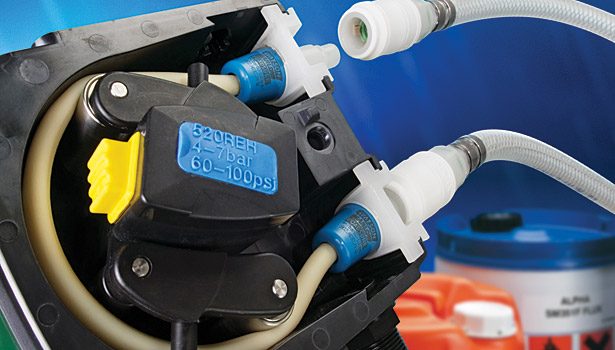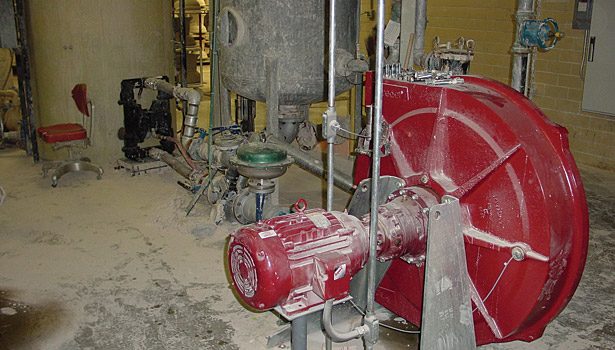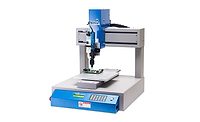Positive displacement pumps can help increase profitability and efficiency.
Positive displacement (PD) pumps are frequently selected in the manufacture, transfer, and application of adhesives or coatings due to viscosity and pressure requirements in these various processes. Many positive displacement pumps offer excellent suction capabilities, high discharge head ratings and are self-priming, making them ideally suited for applications that require consistent flow rates.
Types of PD Pumps
Manufacturers have several positive displacement pump options to consider. Some applications use gear, progressing cavity and air-operated double diaphragm pumps. In many situations, however, these types of equipment have limitations that can adversely affect the process and final product. In these cases, other options are needed, such as sinusoidal or peristaltic hose and tubing pumps.
Sinusoidal Pumps
Sinusoidal pumps incorporate a single shaft with a sine-wave-shaped rotor captured in a housing that creates four moving chambers in a pump stream, conveying material from suction to discharge port. The suction and discharge are separated by a gate that prevents fluid recirculation. The sinusoidal nature of the rotor gives the process a smooth, even flow that can handle soft solids without damaging the pump or the solids suspended in the fluid.
In providing a smooth, pulse-less flow, no special consideration is required for protecting process instrumentation against pressure transients. Blending, coating and mixing operations receive a uniform flow, so the output is consistent throughout the operation. Sine pumps can be operated at temperatures up to 265°F (130°C) without modification, so there is less need to cool the product in the reactor, thus helping to reduce cycle times between batches.
Sinusoidal pumps are used for highly viscous adhesives when filling containers of product from 1-5 gal. The system can fill containers without worry of over- or under-fill due to pulsation.
A wide range of viscosities from water-like to over 1,000,000 cP can be accommodated by a sinusoidal pump. This wide range gives the sinusoidal pump the ability to be unaffected by higher viscosities. In turn, this provides a manufacturing operation with the flexibility to use one pump for many different types of products with varying viscosities. For example, at one operation in Pennsylvania, this viscosity handling ability allowed for the removal of two different pumps in a process stream because of the wide viscosity range of one newly installed sinusoidal pump.
One important feature of the sinusoidal pump is the limited amount of shear imparted to the product. Originally designed for the food industry to handle fruit and vegetables without damage, the sinusoidal pump is able to convey products with minimal change to the fluid rheology. For one adhesive manufacturer in South Carolina, this was the most important reason for installing a sinusoidal pump. The company achieved a higher quality product with less damage, which reduced processing time. Sinusoidal pumps are also used in rail car loading and unloading, bulk transfer from reactor to storage, and delivery to filling machines or coaters.
Peristaltic Hose Pumps
The peristaltic hose pump’s pumping action results from alternately compressing and relaxing a machined hose element between the pump housing and compressing shoes. The fluid ahead of the shoe is pushed gently forward, while the rebounding hose behind the shoe draws more fluid into the hose.
Peristaltic hose pumps use a fabricated, multi-layer hose construction that has wall thickness from approximately 3/8-7/8 in. (10.5-22 mm). This robust wall creates a powerful suction up to 29 ft of water lift, yet is simultaneously capable of continuous operation at discharge pressures over 230 psi. The hose fabrication methods, coupled with machining to exacting tolerances for an elastomeric product, provide repeatable flow and pressure characteristics with each hose installation.
Peristaltic hose pumps operate slowly in pump terms (generally well under 100 rpm). These slower operating speeds decrease line velocities while maximizing the life of the hose. Flows from metering to bulk transfer are accomplished through an array of available sizes.
One primary feature of the peristaltic hose pump is the lack of a mechanical seal. (Mechanical seals frequently require flush water or barrier fluids.) Because there is no seal in a hose pump, only the hose touches the fluid being pumped; this eliminates seal-related maintenance, which is helpful when pumping sticky or high-solid-content adhesives. The product cannot leak, so maintenance is simple and quick. Without seal faces to wear or replace, maintenance is reduced to changing a hose on a preventive/predictive schedule.
Peristaltic hose pumps provide an uninterrupted flow path; the flow path includes no impediments like ball or check valves. Because they are easily cleaned between batches, product changeover time is reduced due to the single product contact point in the fluid path. For a North Carolina-based paper coater, this feature is important because the range of products used requires an effective pump change from batch to batch. With only a hose to replace, this process can be quickly accomplished with minimal downtime. The clear flow path is also useful if a product develops a skin; it can still be passed cleanly through the pump without becoming clogged or entangled. Typically limited to viscosities less than 50,000 cP, the peristaltic hose pump is good choice when pumping PVAs or polymers.
The ability to run dry indefinitely is another feature of the peristaltic hose pump. One northern Ohio manufacturer uses this feature to completely empty a tote of material into a process reactor when manufacturing its adhesive. A different Ohio manufacturer uses this feature to empty a reactor upon completion of a batch without the concern of damaging the pump when the vessel is empty.
A uniform film is important when coating a substrate with adhesive. At a western North Carolina manufacturer, peristaltic hose pumps are used on pan-type coaters to maintain consistent pan levels at a rate slightly exceeding product pick-up. Pan level variations are kept at a minimum with an increase in product turnover by varying the speed of the peristaltic hose pump using a variable frequency drive. Excessive flow can cause foaming, splashing, or unwanted curing of the adhesives, so the required flow is matched to the process. This creates high-quality products by delivering a consistent coat while minimizing product waste.
There is no slip inherent to a peristaltic pump. Complete occlusion (compressing) of the hose while moving the product imparts very low shear into the product. Any shear introduced is a result of the velocity and associated friction losses of the fluid flowing through the process piping, not generated from mechanical elements rotating in the process stream. This extremely low shear keeps product rheology consistent and maintains product quality.
Peristaltic hose pumps have a pulsatile flow generated by the pressing element coming off the hose each revolution. During each revolution, approximately 90% of the pump cycle is a smooth, even flow. The flow only diminishes for a short period of time. The severity of the pulse is a function of system pressure, rotational speed, liquid viscosity and piping arrangement. Slower speeds or larger piping significantly reduce the perceived pulse. In-line or appendage pulsation dampeners can be installed to reduce the effects of the pulsation by up to 90%. In transfer and coating pan applications, the duration of the pulsation is sufficiently short enough to avoid detriment to process parameters. Many continuous processes are also immune to the effects of pulsation.
Peristaltic Tubing Pumps
Peristaltic tubing and hose pumps are similar in that both create suction and discharge through complete occlusion and restitution of an elastomeric pumping element between a housing and rotor. Peristaltic tubing pumps differ from peristaltic hose pumps in several respects, however.
Tubing pumps feature several types of pumping head configurations, depending on the flow and pressure requirements. Tubing is extruded in continuous lengths and installed in pumps as discrete elements or continuous supply lines. Tubing pumps, by the nature of extrusion, are typically rated for a maximum of 12 ft of suction lift and 60 psi peak discharge pressure. Peristaltic tubing pumps more frequently run at speeds up to 265 rpm but are physically smaller and more portable than their hose pump cousins. While this may seem to make peristaltic tubing pumps less useful, some applications do require the operational flexibility provided by the scaled-down characteristics of peristaltic pumps.
At a manufacturer of automotive door seals, a thin, continuous bead of a viscous adhesive is applied to the extruded rubber so that a fibrous material can be evenly applied to prevent vehicle doors from sticking to the body during hot and cold weather. This adhesive bead is applied at rates from 10-30 ml/min, depending on production rates and part size. A tubing pump with a low pulsation head provides the smooth flow needed for a consistent coating of material to meet the automotive manufacturer specification. When the tubing wears, it is a tool-free tubing change, and the process is virtually never shut down for emergency services.
Not all adhesives and coatings are highly viscous; some are in the range of 40-1000 cP. Depending on the process flow requirements, a peristaltic tubing pump can be the solution. The continuous application of an anti-ravel compound to the edge of a technical fabric is one example where a North Carolina-based customer found a peristaltic tubing pump to excel. The anti-ravel compound is applied at a low ml/min rate just before the selvedge is trimmed, maximizing product yield and reducing waste.
Similar to peristaltic hose pumps, the recirculation of adhesive or coating to pan or coating heads is another place peristaltic tubing pumps can provide and increase in profitability. Peristaltic tubing is quick and easy to change; it typically takes less than 1 min for a complete tubing replacement. One manufacturer uses “single minute exchange of die” techniques when going from product to product by having an array of tube assemblies ready to minimize changeover time. The clean hoses and coating pans are installed during product changeover, resulting in less than 10 min of product changeover time vs. a previous time of more than
45 min between cleanup, changeover and startup. The quick tubing changes with no special tools or training make this reduction in downtime possible.
Large, tabletop tubing-style peristaltic pumps can achieve 8+ gal/min of flow, depending on product viscosity. The largest tubing style peristaltic pumps can process slightly more than 30 gal/min with low viscosities, and have been used at up to 3 gal/min at 500,000 cP. With hose lengths of approximately 4 ft and quick connection capabilities, time and cost savings are possible due to hose changes that take less than 3 min with a single common tool.
Find the Right Fit
Not every pump is right for every application. Proper engineering selection and application of the equipment is paramount to having a profitable, trouble-free process. Positive displacement pumps can be ideal candidates for adhesives and other viscous products, but maintenance concerns and product quality should also figure into selecting the right pump. Sinusoidal or peristaltic hose and tubing pumps can be crucial components to increased profitability and uptime.
For more information, visit www.watson-marlow.com.



